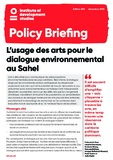L’usage des arts pour le dialogue environnemental au Sahel
| dc.contributor.author | Sow, Fatoumata | |
| dc.contributor.author | Sountoura, Lansine | |
| dc.contributor.author | Niang, Aminata | |
| dc.contributor.author | Ndiaye, Haoussa | |
| dc.contributor.author | Bellwood-Howard, Imogen | |
| dc.contributor.author | Taylor, Peter | |
| dc.contributor.author | Doyle, Julie | |
| dc.coverage.spatial | Burkina Faso | en |
| dc.coverage.spatial | Cameroon | en |
| dc.coverage.spatial | Chad | en |
| dc.coverage.spatial | The Gambia | en |
| dc.coverage.spatial | Guinea Mauritania | en |
| dc.coverage.spatial | Mali | en |
| dc.coverage.spatial | Niger | en |
| dc.coverage.spatial | Nigeria | en |
| dc.coverage.spatial | Senegal | en |
| dc.date.accessioned | 2022-12-01T12:27:28Z | |
| dc.date.available | 2022-12-01T12:27:28Z | |
| dc.date.issued | 2022-12-01 | |
| dc.identifier.citation | Sow, F.; Sountoura, L.; Niang, A.; Ndiaye, H.; Bellwood-Howard, I.; Taylor, P. et Doyle, J. (2022) 'L’usage des arts pour le dialogue environnemental au Sahel', IDS Policy Briefing 205, Brighton: Institute of Development Studies, DOI: 10.19088/IDS.2022.082 | en |
| dc.identifier.issn | 1479-974X | |
| dc.identifier.uri | https://opendocs.ids.ac.uk/opendocs/handle/20.500.12413/17766 | |
| dc.description.abstract | L’art a été utilisé pour communiquer les préoccupations environnementales dans les pays sahéliens. Néanmoins, le dialogue dirigé par les arts entre les acteurs politiques et les citoyens est cependant rare, bien qu’il ait le potentiel de trouver des solutions aux problèmes socio-environnementaux complexes. Il est indispensable d’exploiter ce potentiel, alors que des défis, tels que le changement climatique, s’accélèrent et touchent les populations. La sensibilisation aux processus de dialogue menés par les arts pourrait être renforcée, parallèlement à davantage de recherches sur les contextes dans lesquelles ils sont appropriés et sur la meilleure façon de les utiliser. | en |
| dc.description.abstract | This IDS Policy Briefing contains an English summary and recommendations on page 4. Art has been used to communicate environmental concerns in Sahelian countries. Nevertheless, arts-led dialogue between policy actors and citizens is rare, despite its potential to find solutions to complex socio-environmental problems. Harnessing this potential is essential as challenges such as climate change accelerate. Factors that constrain dialogue include a strongly hierarchical and sectorally divided professional and social context. Artists and citizens also risk confrontation with authorities when they express controversial opinions. Not every situation is therefore appropriate for arts-led dialogue. Yet, when facilitated with humour and effective examples, it can create a relaxed space for intersectoral deliberation. Awareness of arts-led dialogue processes could be increased, along with more research on the contexts in which they are appropriate and how best to use them. | en |
| dc.description.sponsorship | Arts and Humanities Research Council | en |
| dc.language.iso | fr | en |
| dc.publisher | Institute of Development Studies | en |
| dc.relation.ispartofseries | IDS Policy Briefing;205 | |
| dc.rights | Ce rapport est d’accès libre et est distribué selon les termes de la Licence publique Creative Commons Attribution 4.0 International, qui permet l’utilisation, la distribution et la reproduction de tout support d’information pourvu que le mérite de sa création soit imputé à ses auteurs et à sa source, et que toute modification ou adaptation soit indiqué / This is an Open Access briefing distributed under the terms of the Creative Commons Attribution 4.0 International licence (CC BY), which permits unrestricted use, distribution, and reproduction in any medium, provided the original authors and source are credited and any modifications or adaptations are indicated. | en |
| dc.rights.uri | http://creativecommons.org/licenses/by/4.0/ | en |
| dc.subject | Climate Change | en |
| dc.subject | Environment | en |
| dc.subject | Participation | en |
| dc.subject | Politics and Power | en |
| dc.title | L’usage des arts pour le dialogue environnemental au Sahel | en |
| dc.type | IDS Policy Briefing | en |
| dc.rights.holder | Institute of Development Studies | en |
| dc.identifier.team | Rural Futures | en |
| dc.identifier.doi | 10.19088/IDS.2022.082 | |
| dcterms.dateAccepted | 2022-12-01 | |
| rioxxterms.version | VoR | en |
| rioxxterms.versionofrecord | 10.19088/IDS.2022.082 | en |
Files in this item
This item appears in the following Collection(s)
-
IDS Research [1671]
Except where otherwise noted, this item's license is described as Ce rapport est d’accès libre et est distribué selon les termes de la Licence publique Creative Commons Attribution 4.0 International, qui permet l’utilisation, la distribution et la reproduction de tout support d’information pourvu que le mérite de sa création soit imputé à ses auteurs et à sa source, et que toute modification ou adaptation soit indiqué / This is an Open Access briefing distributed under the terms of the Creative Commons Attribution 4.0 International licence (CC BY), which permits unrestricted use, distribution, and reproduction in any medium, provided the original authors and source are credited and any modifications or adaptations are indicated.


